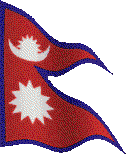
Click HERE for New National Anthem
हाल सम्मका नेपालका सवै प्रधानमन्त्रीहरूको नामावली र कार्यकाल अवधी click
शाह वंश अन्तर्गतका नेपालका राजाहरूको नामावली र शासन अवधी clik here
NEPAL is a beautiful country with many mysterious attractions to be enjoyed. Whether you are more interested in culture, religion or wildlife, you can be sure that there will be a number of attractions in Nepal that appeal to you. As with any country, the attractions may require some physical effort – but that is not to say that everything to be enjoyed in this stunning country necessitates hard work. For the young, healthy and physically fit, hiking from village to village in the Himalayas may prove to be an enchanting option. What better way is there to immerse yourself in the local lifestyle than to make use of trails that the people of the country have been using for centuries. Hiking or trekking is also an awesome way to see some of the country’s spectacular scenery Nepal is a beautiful country with many mysterious attractions to be enjoyed. Whether you are more interested in culture, religion or wildlife, you can be sure that there will be a number of attractions in Nepal that appeal to you. As with any country, the attractions may require some physical effort – but that is not to say that everything to be enjoyed in this stunning country necessitates hard work. For the young, healthy and physically fit, hiking from village to village in the Himalayas may prove to be an enchanting option. What better way is there to immerse yourself in the local lifestyle than to make use of trails that the people of the country have been using for centuries. Hiking or trekking is also an awesome way to see some of the country’s spectacular scenery
introduction $ backgroundFor centuries the Kingdom of Nepal was divided into many principalities. Kirats ruled in the east, the Newars in the Kathmandu Valley, while Gurungs a Magars occupied the mid-west. The Kirats ruled from 300 BC and during their reign, emperor Ashoka arrived from India to build a pillar at Lumbini in memory of Lord Buddha. The Kirats were followed by the Lichhavis whose descendants today are believed to be the Newars of the Kathmandu Valley. During this period, art thrived in Nepal and many of the beautiful woodcarvings and sculptures that are found in the country belong to this era. With the end of the Lichhavi dynasty, Malla kings came to power in 1200 AD and they also con tributed tremendously to Nepal’s art and culture. However, after almost 600 years of rule, the kings were not united among themselves and during the late 11th century, Prithvi Narayan Shah, King of Gorkha, conquered Kathman du and united Nepal into one kingdom. Recognizing the threat of the British Raj in India, he dismissed European missionaries from the country and for more than a century, Nepal remained in isolation. During the mid-I 9th century Jung Bahadur Rana became Nepal’s first prime minister to wield absolute power. He set up an oligarchy and the Shah Kings remained figure-heads. The Ranas were overthrown in a democracy movement of the early 1950s. Today, Nepal enjoys a multi party democratic system with a constitutional Monarch.
In 1951, the Nepalese monarch ended the century-old system of rule by hereditary premiers and instituted a cabinet system of government. Reforms in 1990 established a multiparty democracy within the framework of a constitutional monarchy. A Maoist insurgency, launched in 1996, gained traction and threatened to bring down the regime, especially after a negotiated cease-fire between the Maoists and government forces broke down in August 2003. In 2001, the crown prince massacred ten members of the royal family, including the king and queen, and then took his own life. In October 2002, the new king dismissed the prime minister and his cabinet for “incompetence” after they dissolved the parliament and were subsequently unable to hold elections because of the ongoing insurgency. While stopping short of reestablishing parliament, the king in June 2004 reinstated the most recently elected prime minister who formed a four-party coalition government. Citing dissatisfaction with the government’s lack of progress in addressing the Maoist insurgency and corruption, the king in February 2005 dissolved the government, declared a state of emergency, imprisoned party leaders, and assumed power. The king’s government subsequently released party leaders and officially ended the state of emergency in May 2005, but the monarch retained absolute power until April 2006. After nearly three weeks of mass protests organized by the seven-party opposition and the Maoists, the king allowed parliament to reconvene on 28 April 2006. Following the November 2006 peace accord between the government and the Maoists, an interim constitution was promulgated and the Maoists were allowed to enter parliament in mid-January 2007. Constituent elections are planned for June 2007
MAP ASIA-REFERENCE – total 147,184sq km ,LAND-143,181sq km, WATER-4000sq km BOUNDARIES-total-2926km INDIA-1,690km – CHINA-1,236KM
CLIMATE-varies from cool and severe winter in north to subtropical summers and winters in south
TERRAIN-trai or flat river plain of the Ganges in south, central hill, region rugged Himalayans in north
ELEVATION- lowest point kanchan kalan 70m highest point mount Everest -8848
NATURAL-RESOURCES —quartz, water, timber, hydropower, scenic beauty, small deposits of lignite, copper, cobalt, iron ore quartz, water, timber, hydropower, scenic beauty, small deposits of lignite, copper, cobalt, iron ore
IRRIGATED LAND-11,700 sq km (2003 ) ,LAND USE – arable land: 16.07%
permanent crops: 0.85%
other: 83.08% (2005)
HAZARDS-severe thunderstorms, flooding, landslides, drought, and famine depending on the timing, intensity, and duration of the summer monsoons
ENVIRONMENT-deforestation (overuse of wood for fuel and lack of alternatives); contaminated water (with human and animal wastes, agricultural runoff, and industrial effluents); wildlife conservation; vehicular emissions
INTERNATIONAL AGREEMENTS- Law of the Sea, Ozone Layer Protection, Tropical Timber 83, Tropical Timber 94, Wetlands
signed, but not ratified: Marine Life Conservation
GEOGRAPHY NOTE-
landlocked; strategic location between China and India; contains eight of world’s 10 highest peaks, including Mount Everest and Kanchenjunga – the world’s tallest and third tallest – on the borders with China and India respectively
The population of Nepal was recorded to be about 25 million as of July 2002. Eighty-six percent of Nepalis follow Hinduism, while eight percent follow Buddhism and three percent follow Islam. The population comprises various groups of different races which are further divided into different castes. The distinction in caste and ethnicity is understood more easily with a view of customary layout of the population.
Some of the main groups are such: Gurungs and Magars who live mainly in the western region; Rais, Limbus and Sunwars who live in the eastern mid hills; Sherpas, Manangpas and Lopas who live near the mountains of Everest, Annapurna and Mustang respectively; Newars who live in and around the capital valley of Kathmandu; Tharus, Yadavas, Satar, Rajvanshis and Dhimals who live in the Terai region; and Brahmins, Chhetris and Thakuris generally spread over all parts of the country.
Nepali is the official language of the state, spoken and understood by 100 percent of the population. Multiple ethnic groups speak more than a dozen other languages in about 93 different dialects. English is spoken by many in government and business offices. It is the mode of education in most private schools of Kathmandu and some other cities.
Ethnic Distribution
The Northern Himalayan People
In the northern region of the Himalayas are the Tibetan-speaking groups namely Sherpas, Dolpas, Lopas, Baragaonlis, Manangis. The Sherpas are mainly found in the east in the Solu and Khumbu region; the Baragaonlis and Lopas live in the semi-deserted areas of Upper and Lower Mustang in the Tibetan rain-shadow area; the Managis live in Manang district area; while the Dolpas live in Dolpa district of West Nepal, one of the highest settlements on earth at 4,000 meters.
The Middle Hills and Valley People
Several ethnic groups live together in harmony in the middle hills and valleys. Among them are the Magars, Gurungs, Tamangs, Sunuwars, Newars, Thakalis, Chepangs and majority of Brahmans and Chhetris. The Brahmans and Chhetris have long dominance in all pervading social, religious and political realms. There are also some occupational castes namely: Damai (tailor), Sarki (cobbler), Kami (blacksmith) and Sunar (goldsmiths). Though, there exist numerous dialects, the language of unification is the national language, Nepali.
Ethnic Diversity in the Kathmandu Valley
Kathmandu Valley represents a cultural cauldron of the country, where, people from varied backgrounds have come together to present a melting pot. The natives of the Kathmandu Valley are the Newars. Newari culture is an integration of both Hinduism and Buddhism. The Newars of Kathmandu Valley were traders or farmers by occupation in the old days.
The Terai People
The main ethnic groups in Terai are Tharus, Darai, Kumhal, Majhi and other groups that have roots in India. They speak north Indian dialects like Maithili, Bhojpuri. Owing to the fertile plains of Terai, most inhabitants live on agriculture. There are, however, some occupational castes like Majhi (fisherman), Kumhal (potter) and Danuwar (cart driver).
|
POPULATION
|
28,287,147 |
|
Brahman
|
2896477
|
|
Chhetri
|
3593496
|
|
Chepang
|
52237
|
|
Gurung
|
543571
|
|
Limbu
|
359379
|
|
Muslim
|
971056
|
|
Magar
|
1662241
|
|
Newar
|
1245232
|
|
Rai
|
635151
|
|
Raute
|
658
|
|
Sherpa
|
15462
|
|
Tharu
|
1533879
|
|
Thakuri
|
334120
|
|
Thakali
|
12973
|
|
Tamang
|
1282304
|
Nepali culture Nepal’s culture is greatly influenced by its music, architecture, religion and literature. Your first sight of Nepal may leave you speechless, the great quantities of temples, churches, monasteries and other religious buildings, the hurly-burly in the streets and the number of people and animals socializing on every corner of the narrow cobble-stone lanesThe diversity in Nepal in terms of ethnicity again makes room for various sets of customs. Although some customs have merely been converted to habits without thought, ancient texts justify them with far-fetched reasons, sometimes making sense and sometimes not.
Most of these customs go back to the Hindu and Buddhist traditions. Among them, the rules of marriage are particularly interesting. In traditional families marriage deals are arranged by parents after the boy or girl come of age. Child marriage and polygamy that were once upheld and accepted with glee are not allowed by the law anymore.
Nepalese do not eat beef. There are several reasons for this, one being that the Hindus worship cow. Cow is also the national animal of Nepal. Buffalo meat is a good substitute but is only eaten by a certain section of the population.
Another interesting concept among Nepalis is the division of pure and impure. ‘Jutho,’ referring to food or material that contains another’s saliva, is considered impure by Nepalis. Nepalis consider cow dung to be pure for cleaning purposes.. Most of the Nepalese prefer eating with their right hand, though some people have started using spoons, forks, and knives. While eating with hands. Most of the Nepalese prefer eating with their right hand, though some people have started using spoons, forks, and knives. While eating with hands During menstruation women are considered impure and hence, are kept in seclusion until their fourth day purification bath.
Marriage
The marriageable age has been legally set as 18 for girls and 21 for women. Even today, most people do not have love marriages, the decision is usually made by the parents. Yet, the divorce rate is considerably low.
Pasni
The pasni (rice – feeding) ceremony is the child’s next important occasion. In the presence of family and priests, the seven month old child is dressed in finery and fed rice presented on a coin by all members of the family. He is shown several objects on a tray: a heap of earth, paddy (unhusked rice), bricks, toys, rings, a pen and ink-pot, and a book. It is said his parents can tell the child s future profession from the object he first picks up.
Costumes
Since Nepal is a country rich in ethnicity, there are different costumes worn by different ethnic groups. But generally, the men wear Daura suruwal s and women wear saris.
Tika and kohl lined eyes
Tika, a mark on the forehead, symbolizes the blessings of god. The colours of the tika varies according to the occasion and type of temple one visits. The black gajal or kohl is used to line the eyes of children to keep away evil eyespage up
Nepali is the official language of Nepal, with over 30 other languages spoken as mother-tongues in different parts of the country, and as well there are many regional dialects. Nepali is of the Indo-Aryan family of languages brought from central Asia by the Aryans about 1500 BC. The original Old Indo-Aryan language gave rise to Sanskrit from which Nepali derives.
In common with Hindi, Nepali uses the Devanagri script (the script of the city of the gods, sometimes known as Nagari) which derived from the Brahmi script of ancient India.
English is spoken, with much of the schooling in the cities in the English medium. As well many in the travel and tourism industry speak German, Spanish, Japanese, French and Italian.
In Kathmandu at the Bishwa Bhasha Campus (at Bhrikutimandap) of Tribhuvan University foreign students can study Nepali (spoken and Devanagari script), Newari, Sanskrit and Tibetan languages. At Tribhuvan University in Kirtipur there is the Department of Nepali Studies, where BA and MA studies in Nepali language can be pursued. Sanskrit is also taught in the medical colleges, as many of the texts for natural medicines (ayurvedic and homoeopathic) are written in Sanskrit
Mata Tirtha Snan (Mother’s Day)
This is one of the widely celebrated festivals that falls on the first month, Baisakh (April/May), of the Nepali Year.It is also called Mata Tirtha Aunsi as it falls on a new moon night.
Buddha Jayanti
This day is celebrated to mark the birthday of the Lord Buddha which dates back in about 543 BC.It falls on Jestha Purnima (Full moon night-May/June).
Ghanta Karna Chaturdasi
This festival celebrates the exorcism of the mythical demon Ghantakarna.It is also called Gathemangal festival which falls on trayodashi of the month Shrawan (July/August).
janai purnima rakshay bandhan
Janai Purnima is the festival of Sacred Thread.On this day every Hindu ties a sacred thread on the wrist.It is also called Rakshya Bandhan.On this day, there is a big Mela (fair) at Khumbeshwor, Lalitpur.It is again on a full moon night.
Gaijatra
The festival of “Gai Jatra” (the procession of cows) which is one of the most popular festivals, is generally celebrated in the Nepalese month of Bhadra (August-September).This festival has its roots in the belief that the god of death, Yamaraj, must be feared and hence worshipped.
Shree Krishna Janmastami
Sri Krishna Janmastami marks the celebration of the birth of Lord Sri Krishna. This festival is also known as Krishna Jayanti or Janmashtami. Lord Krishna is regarded as the 8th avatar or ‘incarnation’ of Lord Vishnu.It falls on Saptami of Bhadra (August/September).
Gokarna Aunsi (Father’s Day)
The most auspicious day to honour one’s father is Gokarna Aunsi . It falls on the dark fortnight of Bhadra or in August or in early September.It is also known as Kuse Aunsipage up
teej
Teej” is the fasting festival for women. It takes place in August or early September. The festival is a three-day long celebration that combines sumptuous feasts as well as rigid fasting. Through this religious fasting, hindu women pray for marital bliss, well being of their spouse and children and purification of their own body and soul.
Traditionally, the ritual of Teej is obligatory for all Hindu married women and girls who have reached puberty. Exception is made for the ones who are ill or physically unfit. In such circumstances a priest performs the rites. According to the holy books, the Goddess Parbati fasted and prayed fervently for the great Lord Shiva to become her spouse. Touched by her devotion, he took her for his wife. Goddess Parbati, in gratitude sent her emissary to preach and disseminate this religious fasting among mortal women, promising prosperity and longevity with their family. Thus was born the festival of TeejThe first day of Teej is called the “Dar Khane Din”. On this day the women, both married and unmarried, assemble at one place, in there finest attires and start dancing and singing devotional songs. Admist all this, the grand feast takes place. The jollity often goes on till midnight, after which the 24 – hour fast commences. Some women without a morsel of food or drops of water while others take liquid and fruit.
Gaily dressed women can be seen dancing and singing on the street leading to Shiva temples
The third day of the festival is Rishi Panchami. After the completion of the previous day’s puja, women pay homage to various deities and bathe with red mud found on the roots of the sacred Datiwan bush, along with its leaves. This act of purification is the final ritual of Teej, after which women are considered absolved from all sins. The recent years have witnessed alteration in the rituals, especially concerning the severity, but its essence remains. No matter how agonizing the fast may be Nepalese women have and will always continue to have faith in the austerities of page up.
vijaya dashain
During the month of Kartik in the Bikram Sambat calendar (late September and early October), the Nepalese people indulge in the biggest festival of the year, Dashain. Dashain is the longest and the most auspicious festival in the Nepalese annual calendar, celebrated by Nepalese of all caste and creed throughout the country. The fifteen days of celebration occurs during the bright lunar fortnight ending on the day of the full moonOne of the victory stories told is the Ramayan, where the lord Ram after a big struggle slaughtered Ravana, the fiendish king of demons. It is said that lord Ram was successful in the battle only when goddess Durga was evoked. The main celebration glorifies the triumph of good over evil and is symbolized by goddess Durga slaying the terrible demon Mahisasur, who terrorised the earth in the guise of a brutal water buffalo In preparation for Dashain every home is cleansed and beautifully decorated, painted as an invitation to the mother goddess, so that she may visit and bless the house with good fortune. During this time the reunion of distant and nearby relatives occur in every household. The market is filled with shoppers seeking new clothing, gifts, luxuries and enormous supplies of temple offering for the gods, as well as foodstuffs for the family feasting. Thousands of sheep, goats, ducks, chicken and water buffalo are prepared for the great slaughter. All types of organisations are closed for ten to fifteen days. Labourers are almost impossible to find; from the poor to the rich, all enjoy the festive mood. Anywhere you go the aroma of ‘Vijaya Dashami’ is found nepali people celebrated nine day The first nine days of Dashain are called nawa ratri As days passes by regular rituals are observed till the seventh day. The seventh day is called ‘Fulpati’. On this day the jamara to be used The eighth day is called the ‘Maha Asthami’. The fervour of worship and sacrifice to Durga and Kali increases. On this day many orthodox Hindus will be fasting. Sacrifices are held in almost every house through out the day. The night of the eighth day is called ‘Kal Ratri’, the dark night. Hundreds of goats, sheep and buffaloes are sacrificed at the mother goddess temples. In the darkness of the night Durga temples,The ninth day is called ‘Nawami The tenth day is the ‘Dashami’. On this day we take tika and jamara from our elders and receive their blessing. We visit our elders in their home and get tika from them while our younger ones come to our home to receive blessing from us. The importance of Dasain also lies in the fact that on this day family members from far off and distant relatives come for a visit as well as to receive tika from the head of the family. This function continues for four dayspage up‘ ,
TIHAR HOLIDAY
Tihar, the festival of lights is one of the most dazzling of all Hindu festivals. In this festival we worship Goddess Laxmi, the Goddess of wealth. During the festival all the houses in the city and villages are decorated with lit oil lamps. Thus during the night the entire village or city looks like a sparkling diamond. This festival is celebrated in five days starting from the thirteenth day of the waning moon in October. We also refer to tihar as ‘Panchak Yama’ which literally means ‘the five days of the underworld lord’. We also worship ‘yamaraj’ in different forms in these five days. In other words this festival is meant for life and prosperity.
Goddess Laxmi is the wife of almighty Lord Vishnu. She was formed from the ocean and she has all the wealth of the seas. She sits on a full-grown lotus and her steed is the owl. On the third day of the festival at the stroke of midnight she makes a world tour on her owl looking how she is worshipped.
There is a story, which tells why this revelry is celebrated so widely. Once there was a king who was living his last days of life. His astrologer had told him that a serpent would come and take his life away. The king did not want to die so he has asked the astrologer if there was any way to escape death. The king was advised to sleep with lit oil lamps all around his bed and decorate the palace with oil lamps on laxmi puja day. So goddess laxmi would talk to the serpent not to take his life. It did happen, the serpent was convinced by goddess laxmi. The serpent took the king to Yama Raj and told him that it was not yet the king’s time to come to the underworld. So Yama Raj opened his ledger and in it the kings remaining age was written zero, but the serpent cleverly put seven before zero. Thus the king lived for seventy more years. So onwards tihar is widely celebrated worshipping the underworld and goddess laxmi.
The first day of tihar is known as ‘Kag tihar’, crows day.
The second day is called ‘Kukur tihar’, dogs day.
The third day is the most important day of the festival. It is called ‘Laxmi puja’, The day when we worship goddess of wealth. On this day, early in the morning the cow is worshipped. Tika is put on her head and a garland around her neck then she feasts with delicious food. A cow also symbolises wealth and she is the most holy animal for Hindus. Cow is the national animal of Nepal.
In the evening goddess laxmi is worshipped. Days before the house are cleansed and decorated. For goddess likes clean and tidy places. In the evening a small potion of the house out side the main door is painted red with red mud and an oil lamp is lit on it. A pathway is made from here to the place where the old money box and valuables are kept in the house that is the puja room. All the Nepalese have a box where from generation to generation money is put every year worshipping goddess laxmi. This money is never used unless extreme emergency. The entire house is decorated with lit oil lamps in every doors and windows. Laxmi, goddess of wealth is worshipped performing the traditional rituals and when the rituals are over then gambling in the house starts. This is a festival when gambling is not illegal. On this day throughout the evening groups of girls come to houses singing song of praise of the goddess and they are taken as guests and given gifts. This day the entire place is lively through out the night.
The fourth day is bit different. Today the things you worship depend on your specific cultural background. Normally most of the people perform ‘Guru puja’, ox worshipping.
The last day of tihar is ‘Bhai tika’, putting tika on your brothers by your sisters. The royal astrologer gives the appropriate time to put the tika through the national radio a day before and the entire nation abides by it. Even his majesty receives tika from is sisters. When his majesty receives tika a thirty-one-gun salute is given to honour the function. At this moment the entire nation will be observing bhai tika. The main theme behind bhai tika is the sisters praying for their brother’s long life from Yama Raj, god of the underworldpage up.
Maghe Sankranti
Maghe Sankranti is the beginning of the holy month of Magh, usually the mid of January. It brings an end to the ill-omened month of Poush (mid-december) when all religious ceremonies are forbidden. Even if it is considered the coldest day of the year, it marks the coming of warmer weather and better days of health and fortune.
Shree Panchami
This festival falls in mid Magh (January/February).It is celebrated as the birthday of Saraswati, the Goddess of Learning. She is the lily-white daughter of Shiva and Durga in spotless white robe and seated in a full-blown lotus.
This day is also dedicated to the martyrs of Nepal and hence celebrated as Martyr’s Day.
Maha Shiva Ratri
This day is the celebration dedicated to the Lord Shiva which falls on the Trayodashi of the month Fagun (February/March).
Fagun Purnima (Holi
The ancient Hindu festival of Holi falls on late February or on early March. Allegedly named after the mythical demoness Holika, it is a day when the feast of colours is celebrated. The festival is of a week. However, it’s only the last day that is observed by all with colours.
Ghode Jatra
Ghode Jatra, the Horse Racing Day falls on Darhsa Shrad Aunsi of the month Chaitra (March/April). A grand horse parade takes place at Tundikhel, the central point of the city reputed to have been in the former days the largest parade ground in Asia.
Shree Ram Nawami
Ram Nawami is celebrated in the mid of Chaitra (March/April) as Lord Ram’s Birthday. It is celebrated with much pomp at Janaki temple in Janakpur city, which lies in southern Nepal.
Bagh Jatra
The Bagh Jatra of Pokhara is another cultural baggage brought by Newars from Kathmandu, celebrated in early august. The festival has been celebrated in Pokhara for about 150 years. It expresses the people’s joy at their deliverance from a marauding tiger. On the first day, people dress up like hunters and make an appearance accompanied by musical bands. The next day is an interlude devoted to the showing of comic programs. For three days,the hunting party parades through different parts of the town before “slaying” the beast to end the festivities.
page up
Bhairav Kumari Jatra
This is one of the major religious celebrations in Dolkha, an historic town in north-eastern Nepal (133 km from Kathmandu off the highway to Tibet). The festival falls on early August; and consists of masked dances that go on non-stop for five days. Escorted by musical bands, dancers representing the deities Bhairav and Kumari and other gods and goddesses swirl and sway through Dolkha, visiting its many temples. On the occasion, devotees also undergo fasting and worship Bhairav and Kumari. The ceremony has a history going back more than five centuries.
Chaite Dasain
Chaite Dasain used to be the original day of the grand Dasain festival (which takes place exactly six months later now), but because people got their stomachs upset after feasting on spicy food during the warm month of Chaitra, the grand celebration was shifted to the cooler season. But the religious fervor is still evident in the celebrations of the day.
page up
Gaura Parva
Gaura Parva is another celebration honoring Lord Krishna’s birthday. It is celebrated in far western Nepal with much gusto for two days (August/September). Apart from the many ceremonies that happen during this festival, it is the occasion for married women to put on the sacred thread. The deuda dance is a major part of the festivities in which participants hold hands and form a circle as they step to traditional music.
Gunla
Gunla is a sacred month dedicated to Lord Buddha. This festival commemorates the auspicious “rains retreat” when the Buddha, over 2,500 years ago, led his close disciples into solitary meditation and preached to them the essence of his principles.
Guru Purnima
Teachers come second (after the gods) in the Hindu hierarchy of respect. The full moon day of the month June/July is set aside for students to pay homage to their teachers and receive blessings from them in return. At a place called Vyas on the Kathmandu-Pokhara highway, special worship is performed to Maharishi Vyas, the saint who wrote the great Hindu epic, Mahabharat. For Buddhists, the occasion (Dilla Punhi) is sacred as the day when the Buddha-to-be entered the womb of Queen Mayadevi. Religious functions are held at monasteries and temples to commemorate the event.
Lhosar
Lhosar is the Tibetan New Year which falls on February/March. This festival is mast impressively observed by all the Tibetan-speaking populations. They organize folk songs and dances on this occasion. These dances can be seen in Khumbu, Helambu and other northern regions of Nepal and also at Boudhanath in Kathmandu.
Rato Macchendranath Jatrapage up
(Begins on the full moon day of Baisakh)This is the longest as well as the most important festival of Patan. It begins with several days of ceremonies and the fabrication of a wooden-wheeled chariot at Pulchowk, near the Ashoka Stupa.
Mani Rimdu
(Full moon of the 9th Tibetan month) Mani Rimdu is the biggest event of the year for the Sherpas of the Khumbu region. Sherpas from the Khumbu region congregate at Thyangboche Gompa, the picturesque monastery situated on a spur at 3,870 meters from where both Mt. Everest and Ama Dablam can be seen.
Mata-yaa
Celebrated in mid-August Mata-yaa is one of Patan’s popular festivals. It consists of a day-long procession of devotees going around the Buddhist courtyards of the town and offering worship at the shrines there. Carrying lighted tapers and joss sticks in their hands, Mata-yaa participants rush in a meandering file and visit the hundreds of Buddhist sites scattered all over Patan. They toss rice grains, flowers and coins at the shrines as they pass by. Some devotees wear elaborate and amusing costumes. Musicians also take part in the parade.
Neel Barahi Pyakhanpage up
Neel Barahi Pyakhan is a sacred masked dance which is shown over four days(August/September)in different parts of Bode. Nineteen persons representing the town’s guardian pantheon take part in the dance performance. Music is provided by a 27-piece traditional orchestra. The ceremony invokes peace and harmony, and is dedicated to the deity Neel Barahi whose temple is located in a jungle outside Bode. Bode adjoins Thimi which is 8 km east of Kathmandu.
Rath Yatra
Biratnagar in south-eastern Nepal brings out a spectacular chariot procession to mark Lord Krishna’s birthday (August/September). The parade sets out from the Radha Krishna temple and goes around the town. The six-meter tall chariot carries the images of Krishna and his consort Radha and is drawn by hordes of devotees. The annual chariot festival was started in 1932 to commemorate the building of a temple dedicated to Krishna.
Sita Vivaha Panchami
This festival, commemorating the marriage of Sita to Ram, is particularly celebrated in Janakpur. Each year in Janakpur, idols of Ram and sita are brought out in bright processions and their Hindu wedding ceremony is enacted.
Tamu Dheepage up
Tamu Dhee (also known as Trahonte) is a Gurung holiday (august). Ceremonies are performed to purge the neighborhood of evil spirits and to safeguard one’s farm and farm animals from hostile elements. The festival can be observed in Pokhara. Groups of people beating on different kinds of drums form a colorful procession and make house-to-house visits. Participants with their faces smeared with soot and wearing feather headdresses parade through the town to drive away negative influences and ensure peace and security.
Tansen Jatra
The hilltop town of Tansen in central Nepal exults in a week-long festive spree beginning with Janai Purnima, when Hindus change their sacred threads. The next day, Gai Jatra is marked by parading figures of cows made of bamboo and cloth. Ropai Jatra is the rice planting ceremony and participants perform plowing and planting acts on the streets. During Bagh Jatra, actors dressed up like tigers and hunters march through town. Then there are the parades. Images of Ganesh, Bhimsen and Narayan are placed on palanquins and carried around Tansen. The celebrations climax on August 12 with Bhagawati Jatra, the procession of the town’s protective goddess.
Taya Macha
The Taya Macha dance is shown in different parts of Pokhara as part of the Gai Jatra observances. The five dancers, four dressed up as angels and one as a clown, are accompanied by a group of traditional musicians. It is believed that the performance will bring peace to the souls of those who have passed away during the previous year. The festival has its roots in the Kathmandu Valley. It was brought to Pokhara by Newars who migrated here centuries ago.
Yomari Punhi
Yomari Punhi is one of the popular Newar festivals observed every year during the full moon of December. A yomari is a confection of rice-flour (from the new harvest)dough shaped like fig and filled with brown cane sugar and sesame seeds, which is then steamed.
page up
Nepal is a multi-cultural, multi-ethnic nation. So, diversity is observed in feeding and drinking habits as well. However, a typical hilli staple food consist of Dal-Bhat [2] (lentil soup and cooked rice) with Tarkari, that is, vegetable curries. This is consumed twice daily, generally in the morning, and shortly after the sunset. Between these main meals, , during mid-day, snacks like chura/Baji (beaten rice) and tea are consumed. Sometimes, meat, eggs, and fish preparations are also consumed. Most of the Nepalese prefer eating with their right hand, though some people have started using spoons, forks, and knives. While eating with hands, lentil soup is poured over cooked rice, a little vegetable curries are added, and the chunk so prepared is consumed by right hand. Millet, maize, wheat bread(roti) are also consumed as staple food in certain areas.
With ethnic diversity, Nepal also presents a diversity in its eating habits and there are variety of foods, particularly consumed during festivals, and on special occasions. A festive meal, like one served during a marriage, is a real treat, and include vegetarian as well as non-vegetarian dishes. Some of such vegetarian preparations are: Baji (a preparation from flattened rice), Wauncha Tukan (green mustard vegetable), Bhuti (a preparation of white beans), Pharsi (pumpkin curry), Lainsoo (dried radish curry), Simpu (bran curry), Pahmaya (curry of green pulsespulse), Hamoh Kwa (sesame seed curry), Chhou Kwa (bamboo shoot soup), Dhau (yogurt), Sakhah (brown sugar to accompany dhau), and Sisabusa (raw radish, raw peas, and fresh fruit pieces). Meat preparations may include Della (meat placed atop baji), Tahkugu Pukala (big slice of fried meat), Cheekugu Pukala (small pieces of fried meant), Tahkha (jelly meat), Chhakoola (meat pieces in curry), Dayekala (meat curry), Hayenla (meat curry with ginger), Gorma (white jellied meat
Rakshi is one of the traditionally distilled alcoholic drink of Nepal. It is made from millet, and is currently in the process of being banned by many mothers’ unions in Nepal.homemade drinks
Rakshi or Ayla is fire water distilled from rice. It is colorless and best drunk neat. Thon, the milky white juice of fermented rice, is the driving force behind many festivals in Kathmandu. The Tibetan version is called Chhyang. Tongba is a popular energizer in the hills. It is made by pouring hot water into a pot of fermented millet and drunk with a bamboo straw.
Chatanmari – Rice flour pizza with meat or egg topping or plain. A just reward after a hard day’s sight-seeing.
Chhoyla – Roasted meat diced and spiced, a versatile snack. Chomp it with flattened rice and wash everything down with homemade liquor.
Gundruk-ko Jhol – A soup of dried and fermented green vegetables. Slightly sour, slightly tangy, it’ll have you smacking your lips.
Kwati – Soup of different sprouted beans. A festival specialty and great way to begin dinner.
Momo-cha – Dumplings filled with minced meat, served steamed or fried. Terrifically popular appetizer, afternoon snack or evening meal. Do you know how to make Momo-cha? Learn more…
Samay Baji – A ritual dish consisting of flattened rice, roasted meat, smoked fish, boiled egg, black soybeans and diced ginger.
Sekuwa – Barbecued meat. Mutton, duck, chicken, buff, wild boar – take your pick. Goes famously with drinks.
Sukuti – Hot and spicy concoction of dried meat roasted over a charcoal fire. Something to munch on between sips.
Tama-ko Jhol – Hot and sour soup of bamboo shoots.
Tawkhaa – Jellied meat curry served cold. With a plate of Tawkhaa and a glass of wine by your side, who needs a festival?
Wo – Lentil flour patty with or without meat/egg topping. As a festival snack or an afternoon bite, nothing even comes closmain dishes
Aloo Tama – Bamboo shoot and potato curry enlivened with a variety of spices and herbs.
Beans – A curry preparation of large and small beans to go with the main course of rice.
Dal – Lentil soup eaten with plain rice and one-third of the famous dal-bhat-tarkari combination. Popular lentils are the black, green and yellow varieties.
Green Vegetables – Spinach, mustard greens or broad-leaved mustard. A standard accompaniment to plain rice for lunch or dinner.
Meat Curries – Curried meat with lots of spices and gravy served with the main course of rice. Comes in buff, mutton, chicken or fish varieties.
Bhat (Plain Rice) – Good old boiled rice, the staple Nepalese nourishment and the central ingredient of the dal-bhat-tarkari diet.
Tarkari – vegetable curry in a rich spicy broth, the third element of the dal-bhat-tarkari staple meal relishes
Achar – A pickle to ‘‘brighten up your mouth”. Can be made of ground tomatoes, sliced radish, ground coriander, boiled and diced potatoes and other ingredients.
Gundruk – Dried and fermented green vegetables. Legendary accompaniment to meals in the hills of NepalSanya Khuna – Jellied fish soup served cold. Spicy, hot and tangy. Terrific accompaniment to rice desserts
Juju Dhau – Delicious creamy curd from Bhaktapur, a must at all feasts. Juju Dhau literally means ‘‘king curd
Sikarni – Yogurt preparation mixed wipage up
Nepal does not have the most active nightlife, yet it does exist and the young at heart will certainly be satisfied with the selection. Nepal’s nightlife is focuse around tourist areas, particularly Thamel in Kathmandu. The nightlife in Nepal has something to offer everyone.
Nepal does not have the most active nightlife, yet it does exist and the young at heart will certainly be satisfied with the selection. Nepal’s nightlife is focused around tourist areas, particularly Thamel in Kathmandu. The nightlife in Nepal has something to offer everyone.
Nepalese clothes, both traditional and modern, are common and easily available souvenirs. Beginning at the head, Nepalese caps or ‘topis’ are available in the lndrachowk and Asan areas of Kathmandu, as well as in the market areas of most of
Nepal’s towns and cities. One can either buy a black topi (popularly known as ‘Bhadgaonle topi’ as it was first made in Bhadgaon) or a colorful printed cap, known here as ‘dhaka topi specially, Nepalese’s man warring marriage and party whit daura and kurta topi Nepalese government does not give citizenship whit out putting topi (nepali cap)
Nepalese woollen jackets are also very popular, especially during the winter months, and can be purchased in most tourist shops at a reasonable price. There is a variety of different colours and designs and although size fittings are not given, most shopkeepers are haply to let potential buyers try on a number of different jackets until they find a suitable one. As all jackets are made by hand, it is also possible to design one’s own jacket at a tailoring shop.
Whereas jackets are suitable for both ladies and gentlemen, pashmina shawls are mainly a ladies’ souvenir item. The name pashmina refers to the extremely soft and warm underhair of a variety of mountain goat found in the upper regions of Nepal.
Pashmina shawls come in different colours and designs, the natural colour being a dark ash-gray. Scarves and mufflers of the same material are also available. For the warmer months, cotton garments such as the traditional daura (shirt) and suruwal (trousers) worn by the men, woman sari guniyo choli pacheuti and lable in most bazaar areas



























we can not belive barhman & chhetri have mare population in nepal.
Mager population is more in nepal .
that calculation is totally worng and Political opinions .
is it possible that we don’t talk about cast…!!!!!!!!
we are in 21st centuary …and we live as human being….
do we know who we are b4 we born?
or do we know who we will be after we die….?
lets be just nepali…
common brother !!! !!
lets not build a barrior….between us.
Mr. Dinesh if you don’t mind could you please let me know according to you How many Magars are there???? what about Tamangs???? do you think its only around 13 lakhs??? & by d way i guess brahmin & chetris are having higher population but the figure is wrong… by the way, i don’t understand the meaning of MUSLIM is there any caste like that in nepal????
Whoever written this article, i want to request him to change the tab head to english or change the whole article to Nepali coz if you don’t change the tab head to english then its useless to wright the article in English….
furthermore, the whole article actully is bullshit…. its not giving good information in any aspects… the purpose of the article is not fully covered… so many spelling mistakes…
At last but not the least, i would like to request the writer to give some pictures as a prove wherever its necessory…
for example while you are describing “Bhadgaule Topi” & “Dhaka Topi”, i guess it will be far better if you give the pictures then everybody will know perfectly about it….
Jadau
Dear Editor,
Namaskar,
hello it is my pleasure to write u comment for this Article , i did not understant the ratio of the Total population but there is Muslim is not caste and if u think that is caste what about the CHRISTIAN ?? DON’T YOU KNOW THERE ARE LOST OF CHRISTIAN AND THEY ARE doing a lot of Social service at Nepal ? i think you don;t know so that i am going to EXplan about the some of the Social works that the CHRISTIAN COMMUNITY ARE DOING SOCIAL WORK,
1. UMN( UNITED MISSION TO NEPAL, THEY HAVE 5 HOSPITAL IN NEPAL EXAPLE -PATAN HOSPITAL , REST OF 4 ARE OUT OF KATHMANDU . SO THERE ARE LOTS OF CHRISTIAN NOW SO I THINK U DID NOT KNOW ABOUT THAT.
JEEVAN KC
SBC GENERAL TRADING & CONTACTING COMPANY W.L.L.
KUWAIT
65046001
Better and best, are essentially talking about change. It’s about being in a state of change. By definition, once you’re the best there is literally nowhere else to go. Being the best is already a dead end. Being better however merely means you need to be better than who you are today. And in every day following there has to be a spark of growth at the very least. So if you are continuously bettering yourself there can never be a place where you are best….
..there where our leader shoud differenciate…..themself..rather….waiting for thier turn to be any minister therefore can build…..better future…
to delete this concept….we need to be as united as possible..the young generation!!!!!!!!!!!!!!
and yes we can build our nation….
+965 66915938
rajnet2006@yahoo.com
Dear Editor,
Many Thanks for write about the nepal,nepali culture and cast in nepal.But do u know how many castes in nepal and papulation? May be you don’t know about the “DURA”. So it is better to study the history of nepal properly and about the casts….
BHUPAL DURA
Alghanim Industries
Kuwait.
Well, keeping at bay all much commented stuffs (here), nepalkuwait has done a wonderful job by bringing forth information about Nepal. Its because, I being in USA, have found a lot of foreigners interested to know more about this mountainous kingdom blessed with all sorts of natural beauty. But, I myself not being a Nepalse citizen, find hard to give full description of Nepal. I having seen this site and tis information in particular, now can suggest them to ave a look at it should anyone asks me about Nepal and its geographical, demographic, social, political and other aspects
Tilak
core group member
Bhutanusa.com
good news keep it up
i m proud of this nepalkuwait .web it will keep all of the nepali almost who have some relation or depend job in kuwait i hope its always best n freshnews updated thanx
thanks all,nepalkuwait.com
ow its good n proud of nepalese people for all over the world this nepalkuwait .cm is realy perfect 4 whole nepali mostly 7march of news nepali calture relagion and all .i hope next time it wil be updated more fresh n true history of nepal n outside news best of luck .ramupanday.arghakhanchi dharapani nw kuwait 99264523